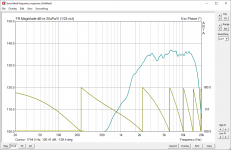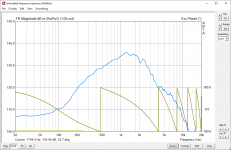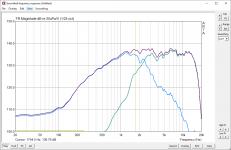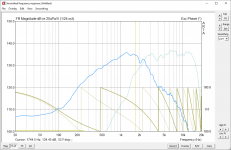I think, how can you answer your original question unless you can find the way to produce the least amount of diffraction. This way you can see what is truly the tweeter's fault.Of course, 'baffle-less' was to be intended 'without' any baffle around.
There is no magician;
"pay no attention to the man behind the curtain!!"
As Steve likes to remind us, it helps to have an idea.
You have the tools, and have learned to use them, but you need to study what has worked with what components in what conditions. and find satsfactory explanations of why a given technique worked in its instance.
It might help to read a few books that give an overview, remember, you can have a garage full of tools, but lacking an understanding of valve timing, expansion coefficients, etc. you will be unlikely to successfully build a Ferrari V-12.
I'm sorry that it's not plug-and-play, but audio is squishy.
We have waves responding differently to various materials(air, the structure and furnishings of the room), and it all changes with the shapes of the room(and speaker) and wavelengths of the sounds.
Don't be discouraged, it's just not instant.
"pay no attention to the man behind the curtain!!"
As Steve likes to remind us, it helps to have an idea.
You have the tools, and have learned to use them, but you need to study what has worked with what components in what conditions. and find satsfactory explanations of why a given technique worked in its instance.
It might help to read a few books that give an overview, remember, you can have a garage full of tools, but lacking an understanding of valve timing, expansion coefficients, etc. you will be unlikely to successfully build a Ferrari V-12.
I'm sorry that it's not plug-and-play, but audio is squishy.
We have waves responding differently to various materials(air, the structure and furnishings of the room), and it all changes with the shapes of the room(and speaker) and wavelengths of the sounds.
Don't be discouraged, it's just not instant.
This is not how you do it. If you want to remove the baffle you'll want to use a large baffle.
Thank you. Words of wisdom and experience.
Ref: Augsburger, Olsen, Beranek, etc.
Thank you! I've already read Vance Dickason's cookbook and D'Appolito's about measuring loudspeakers, can you suggest any other book about crossover design please?There is no magician;
...cut...
It might help to read a few books that give an overview, remember, you can have a garage full of tools, but lacking an understanding of valve timing, expansion coefficients, etc. you will be unlikely to successfully build a Ferrari V-12.
...cut...
Don't be discouraged, it's just not instant.
However, I've just found something that certainly is going to become another milestone in my learning way. It's the Michael Chua article on his project Starling TA in which he demonstrates that speakers which are not time aligned have phasing issues which can clearly be heard in the sibilance. I think my project have so two kind of problem, diffraction and time misalignment, maybe more the second one. Time alignment sounds well even when response curve is not perfectly flat, and viceversa a curve perfectly flat can sound harsh and sibylating if not time-aligned.
What exactly is "time alignment"? I can control drivers' phases in simulations, are drivers time-aligned when phases overlap perfectly around crosspoint?
I've got the 2 books you mention above. The D'Appolito one is good but for me personally the best book I've read is Floyd Toole Sound Reproduction
It isn't about building speakers as such but it has really helped me with setting them up once built.
Rob.
It isn't about building speakers as such but it has really helped me with setting them up once built.
Rob.
Regarding Time ALignment theory, I reviewed my measurements and cross-point between SS D2905-9500 and Vifa TC9FD18 and discovered this (measurements took at 25 cm to lower diffraction influences):
SS filtered response:

Vifa filtered response:

total response:

SS + Vifa overlayed:

Now I'm even more confused because I don't understand why at cross-point relative phase is quite exactly 180° while tweeter and mid has already inverted polarity and in fact total response if goos at cross-point and doesn't reveal any dip (foolishly I didn't take null-reverse mesasurement).
Please can somebody explain what does it mean this 180° shift?
Thank you very much.
SS filtered response:

Vifa filtered response:

total response:

SS + Vifa overlayed:

Now I'm even more confused because I don't understand why at cross-point relative phase is quite exactly 180° while tweeter and mid has already inverted polarity and in fact total response if goos at cross-point and doesn't reveal any dip (foolishly I didn't take null-reverse mesasurement).
Please can somebody explain what does it mean this 180° shift?
Thank you very much.
Please can somebody explain what does it mean this 180° shift?
Are you using an USB mic with ARTA? That would explain the phenomenon. With an USB mic like UMIK-1 or similar, the timing is unreliable from multiple measurements. Of course you can do a reverse null test because it takes just one measurenent instead of two or more.
Are you using an USB mic with ARTA? That would explain the phenomenon. With an USB mic like UMIK-1 or similar, the timing is unreliable from multiple measurements. Of course you can do a reverse null test because it takes just one measurenent instead of two or more.
No, I use a Dayton 'normal' mic with an analog preamp and a sound-card for A/D conversion. May it be because I've made single channel measurements? (I wasn't able to make dual channel because of erroneous results)
Thanks
Anyway, the individual phase rotations looks similar, the combined response is flat and roughly -6 dB at the xo point. I bet the reverse null test would show a deep symmetrical cancellation.
Anyway, the individual phase rotations looks similar, the combined response is flat and roughly -6 dB at the xo point. I bet the reverse null test would show a deep symmetrical cancellation.
I was happy of this before to listen but..... sonically result is a ruin 😡
I was happy of this before to listen but..... sonically result is a ruin 😡
Are you tried to dial down the tweeter level a few dB?
In small reflective rooms there is usually too much high frequency energy in the lower to mid treble if the speaker tuned to flat on-axis response because of the very wide dispersion of the tweeter below 5-6 kHz.
The peak around 3 kHz just makes things worse, which seems a diffraction effect. Imo this is a good example why waveguides are developed, especially for tweeters.
Are you tried to dial down the tweeter level a few dB?
In small reflective rooms there is usually too much high frequency energy in the lower to mid treble if the speaker tuned to flat on-axis response because of the very wide dispersion of the tweeter below 5-6 kHz.
The peak around 3 kHz just makes things worse, which seems a diffraction effect. Imo this is a good example why waveguides are developed, especially for tweeters.
Well, great, finally I have confirm about opportunity to use waveguide, as I had supposed among various ideas, thank you very much.
I've just found this interesting project Revelation Two – M4 WG by Audioexcite, apart filter topology which is totally different from my target, but usable as another reference.
Well, great, finally I have confirm about opportunity to use waveguide, as I had supposed among various ideas
That's great, and good to see that SS Classic fits on the WG148 with a little effort.
I was happy of this before to listen but..... sonically result is a ruin 😡
Have you tried to analyse the decay of a pure tone impusion located in the notch ?
How looks the unsmoothed FR ?
Have you tried to analyse the decay of a pure tone impusion located in the notch ?
How looks the unsmoothed FR ?
I'm not sure to be able to do it, I've never done one, but for sure I'll try to do the next time, thanks. Unsmoothed FR is right what I published..
Please, have you ever done dual gated FR measurements in ARTA? I wasn't able to understand how to..
Thank you
I'm not sure to be able to do it, I've never done one, but for sure I'll try to do the next time, thanks. Unsmoothed FR is right what I published..
Please, have you ever done dual gated FR measurements in ARTA? I wasn't able to understand how to..
Thank you
I only use REW.
Try sliding your gate right while sliding your eyes left along your response plot. HolmImpulse does multi-gating. It is related to perception rather than reflections. Is it the tool you need?dual gated
Try sliding your gate right while sliding your eyes left along your response plot. HolmImpulse does multi-gating. It is related to perception rather than reflections. Is it the tool you need?
Yes but I didn't understand: in Arta in single-gated measurements gate must be choosen more right possible but before first reflection wave, and more right I can fix it and more left is extended frequency response, all clear for me.
I didn't understand how to fix second gate and indeed how does it work.
Thank you.
Maybe it is a bad idea to use it when you are looking at a problem like this? It blends post reflection information into the responses to extend the bandwidth. Does bandwidth help you at this time?
Maybe it is a bad idea to use it when you are looking at a problem like this? It blends post reflection information into the responses to extend the bandwidth. Does bandwidth help you at this time?
Certainly it's not useful at all to study mid-treble cross point but I'd find rather useful to compare some low part of response between different bass driver solution, just because ear aren't always objective and memory-proof. I've asked just because Arta's manual isn't really clear about dual gate explanation and if I try to use it says that gate is too small, while single gate works well and I'm able to use.
- Home
- Loudspeakers
- Multi-Way
- May my problem be diffraction?